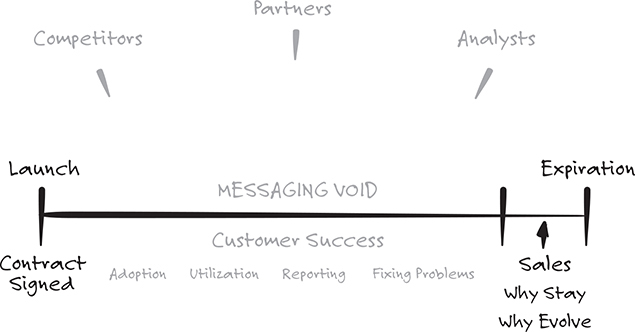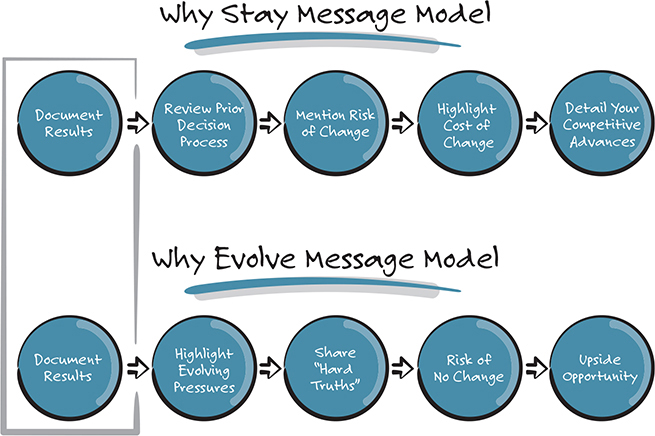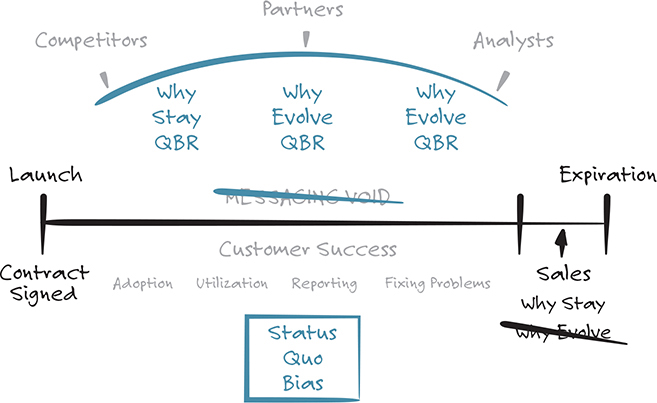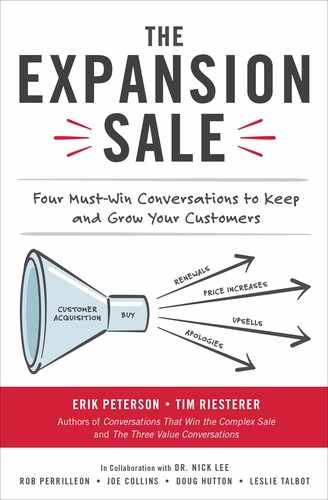 13
13 
Expansion Messaging as a Commercial Strategy
If your job is to lead teams, scale organizations, or design your company’s commercial strategy, this chapter is for you.
Throughout this book, you’ve learned a series of useful frameworks that will help you make great tactical decisions to manage acute commercial moments with existing customers. But when you’re trying to drive companywide transformation, you also need to know the obstacles you’re likely to face. These obstacles are anchored in your old customer engagement motion. To get the full value from everything you’ve learned in this book, you must break this motion.
In this chapter, you’ll learn the three key moves that support this strategic transformation:
• Changing your messaging cadence in the customer life cycle
• Changing the content of your business reviews
• Changing the focus of your launch meetings
But first, let’s take a look at what so many organizations get wrong.
If you’re like most organizations, your customer engagement motion follows a logical flow. First, you sign a new client. Then, your salesperson hands the client off to a post-sales team, such as a customer success manager, or maybe someone with a different title but the same basic function. Then, that customer success manager works with the customer on adoption, utilization, reporting, and fixing any problems that crop up.
During this time, your salesperson is only peripherally involved with the account. They might be doing check-ins with the customer, but the salesperson is mostly staying out of the way as the solution gets implemented. It’s only when the contract nears its end that the salesperson re-engages, because the salesperson knows this is when the customer has to make a decision. Do they renew and extend the contract? Do they expand into new offerings from your company? Do they move to a competitor? Do they figure out a way to do this as an in-house solution?
Now, assuming you’ve taught your sales team the Why Stay and Why Evolve frameworks you’ve learned about in this book, where will the sales team apply them? Most likely in the same place where they normally re-engage with the customer: the end of the contract (Figure 13.1).

Figure 13.1 Most sellers wait until a contract is about to expire before re-engaging.
This is a mistake.
Before explaining why, let’s take a look at some of the beliefs that drive your salespeople’s engagement strategy.
There are two possible reasons salespeople don’t engage the customer until the end of a sales cycle:
1. The salesperson might have sold the customer everything there was to buy. As a result, the salesperson is focused on finding new customers who can make a purchase now. There’s some legitimacy to this approach, though most salespeople would be better served by staying engaged with the customer over the length of the contract. Remember, one of your advantages with existing customers is their Status Quo Bias. Reinforcing the customer’s relationship with their salesperson over the length of the contract gives you one more piece of status quo, in this case the seller-customer relationship, to leverage in your favor when it comes time for a renewal or contract extension.
2. The salesperson believes that customers don’t want to be sold something new while they’re already under contract. It feels “wrong” or “rude” to present an existing customer with upgrades or additional services they should consider buying when the contract isn’t yet at its end. Instead, it seems best to let the customer get to the end of the contract before trying to sell them something more. Plus, the customer is likely to have experienced more “value” toward the end of the contract, which should make it easier to then sell them the next thing. At least, that’s the rationalization.
The underlying flaw in both these mindsets becomes apparent when you look at what this means to the customer experience. When you take this approach, your customer is experiencing a Messaging Void from your organization over most of the length of the contract (Figure 13.2).

Figure 13.2 When sellers don’t engage with customers throughout the contract life, they create a Messaging Void.
At first glance, you might think, “That’s okay. Our customer is safely under contract with us. We can wait until the end to message to them.” But that’s an incorrect—and dangerous—assumption.
Is it really true that your customer is not experiencing any messaging during the Messaging Void you’ve created in your engagement strategy? Of course not.
Your customer is being bombarded with messaging—from your competitors, your partners, and industry analysts, just to name a few (Figure 13.3).

Figure 13.3 In the absence of your messaging, competitors fill the void.
And what kind of message are they bringing to your customer? The most disruptive messages they can come up with.
Your competition knows you’re the status quo, and their first goal is to disrupt that status quo. So, while you’ve created this Messaging Void out of a mistaken assumption that your customers will be grateful, you’re also allowing your competition to reset your customer’s beliefs around how they should solve their core business problems.
When you allow your Messaging Void to be filled by others who are not your friends and who are, in fact, actively working against your interests, by the time your sales team delivers your message at the end of the contract, it’s too late. You’ve already failed to articulate value. In fact, your customers already know a lot of what you want to talk to them about because they’ve heard it from everyone else, and their first question for you is, “Why haven’t you been talking to us about any of this?”
Now you might be thinking, “That’s not true. We don’t have a Messaging Void, because our customer success team is engaging with the customer throughout the lifetime of the contract with Quarterly Business Reviews.” (Note: These could be monthly or biannual reviews, or any other length of time, but for simplicity’s sake, we’ll use QBRs as shorthand for any regularly scheduled business review for the rest of this chapter.)
As mentioned earlier, the customer success team onboards the customer during the launch phase. They track metrics like adoption, utilization, and reporting, and if there are any problems, they fix them along the way (hopefully, applying the Why Forgive framework if necessary). And they communicate these things to the customer during QBRs (Figure 13.4). Isn’t that filling the Messaging Void?

Figure 13.4 Activity does not equal messaging.
Certainly, there’s a lot of activity taking place during this period, and there are, presumably, a lot of conversations happening. But what’s likely not happening is any sort of messaging that communicates value. In reality, most of these conversations are more accurately described as data exchanges and status updates. And it’s often at a level that is non-strategic, which is also why the first QBR an executive attends is often the last QBR that executive attends. Why? Because you’re not speaking to her issues and concerns.
Since messaging is properly understood as the communication of value, these QBR conversations don’t fill the Messaging Void.
And here is where the Why Stay and Why Evolve frameworks come to the rescue. Those frameworks were explicitly built to communicate value, and, as it turns out, they’re also great frameworks for QBRs.
In your early QBRs, you should be telling your Why Stay story, which is a story of why the customer made a good choice. It shows the customer that everything is going according to plan and reinforces the decision they made to choose you.
But before too long, you need to shift your QBRs to tell a Why Evolve story.
This isn’t something you want to save for the end of the contract. In fact, what our research shows is that if you save it for the very end, you’ll disrupt their thinking.
If you disrupt their thinking too much, you’re essentially pushing them to look at what other options might be out there that they haven’t yet explored. You don’t want to take that risk at the end of the contract. Instead, you want to introduce the idea of evolving when you’re still in the comfortable confines of the contract. Your communication cadence should look more like Figure 13.5.

Figure 13.5 Introduce your Why Evolve message when you’re safe within the contract.
When you change your messaging cadence and use the frameworks as the flow of your QBRs, you’re actually helping customer success do the most important job that customer success has, which is communicating value.
Nevertheless, you should be prepared for some resistance from your customer success team.
Many customer success managers are reluctant to do anything that feels like “selling” to their customers. They want their customers to believe the customer success manager is grateful for their business and is working incessantly to delight them every day. In fact, they likely pride themselves on their “niceness.” They’ll even go so far as to describe themselves as the people the customer can trust (as opposed to salespeople).
The last thing a customer success manager wants to do is upset this view of themselves by doing something that feels like selling. And to be clear, we aren’t suggesting that you turn your customer success people into salespeople. But what they do need to become is value communicators.
Pleasing the customer is undoubtedly an important part of their job. But your company didn’t invest in these support teams only to make sure a customer is happy. Your company invested in these teams to make sure a customer is retained, and ultimately, to make sure your business with the customer expands.
And if that’s the goal, how do you make it happen?
You do that by articulating value.
And that leads to the third change you need to make to your commercial strategy.
To understand the next change, you need to quickly review the content in the Why Stay and Why Evolve frameworks. These message frameworks are markedly different from one another. Each has five motions, five message components, that build the story. But one focuses on reinforcing Status Quo Bias, while the other introduces a little disruption.
However, there’s one component that’s the same for both, and that is the first step: Documenting Results (Figure 13.6).

Figure 13.6 Documenting Results is the common element.
Interestingly, what we’ve seen in customer after customer who have rolled out these frameworks is that this is often the weakest, and most difficult, part of the message to master. And yet, this is the component that will make the most difference when it comes to filling your Messaging Void, starting with the launch.
MASTER THE LAUNCH
Picture the typical launch meeting. If you sell a relatively high-ticket item, it probably takes place at the customer’s headquarters, in the “good” conference room, with all the team members from both sides arrayed around a big mahogany table. For smaller customers or lower ticket items, it might take place virtually. Either way, there are introductions and a round of congratulations for finally getting the project off the ground. Then the customer success lead asks the customer what their goals for the implementation are.
And that’s where things begin to go wrong.
When you ask the customer what their implementation goals are, you’ll often elicit a response like, “We’re looking to roll out to X many people within this time frame, integrate it with these internal systems, and complete everything by X date.”
If you’re the customer success lead, you say, “Great!” You diligently write these things down. These become your goals, and thus become the goals you report back on in your QBRs.
Now imagine you’ve been fortunate enough to get the most senior executive sponsor in the room for this all-important launch meeting. Did she buy your solution because she desperately wanted to track how many people are using it, how much time they’ve spent in it, and when the integrations happen? Of course not.
She bought it to enable larger, more strategic business goals, and because you skipped over them to focus on tactical milestones, this will probably be the last meeting she attends.
That’s a missed messaging opportunity.
The launch meeting should set the agenda for all subsequent meetings and serve as the foundation of your expansion strategy.
Don’t rush through the discussion of success metrics. Linger in it. And don’t settle for the easily collectable but often unimportant metrics. Use the Triple Metric you learned about in Chapter 11 to guide the conversation to get to the important metrics—the ones that matter at the executive levels. Resist the urge to simply jot down the customer’s initial implementation goals and instead push for the customer to describe the Project level, Business Unit level, and Corporate level goals they want to achieve with this initiative.
And don’t be afraid to ask tough questions, such as how they’re going to measure those goals.
Measuring these goals shouldn’t fall only on customer success. Often, the most important goals will only be measurable by metrics available on the customer side. That’s okay.
What you need is agreement that those are the goals by which success will be measured. And that both sides owe it to each other to track performance against those goals and report back to the team. If you’re used to being responsible for all reporting on project performance, this might feel strange to you. But what you’ll see is that these are the goals that motivate executive engagement.
Also, be prepared for some customer resistance here. Lower level people in the meeting will want to pick the easy goals that are entirely your responsibility as a vendor. You can easily measure usage for them, as an example. But if you let those be the only metrics captured, you’ve now guaranteed that your executive sponsor will lose faith in your ability to impact their organization. Those metrics aren’t meaningful to her.
And the ripple effect of the failure to capture meaningful goals is profound. Remember how your Why Stay story and your Why Evolve story start? By Documenting Results. If you don’t do a good job capturing the real goals during your launch meeting, you’ll have nothing meaningful to tie your messaging back to during key messaging moments in the customer relationship. By the time you get to the end of the contract, you’ll be left with nothing much more than, “Stick with us. We’ve been nice.”
FILL THE VOID
To take full advantage of what you’ve learned in this book, you need to break your old engagement motion and redesign your commercial strategy. Don’t let old habits get in the way of executing on these frameworks. Lead your team to a new level of performance by:
• Changing your messaging cadence across the customer life cycle
• Changing the content and flow of your business reviews
• Changing the focus of your launch meetings
When you do that, you’ll fill your Messaging Void with conversations that communicate value from the beginning to the end of the contract. And your new commercial strategy will naturally reinforce your customer’s Status Quo Bias so much that it will create a nearly impenetrable psychological shield—protecting your relationship with your customer from your competitors (Figure 13.7).

Figure 13.7 Keep and grow customer relationships through value-based conversations.
Ultimately, applying this new messaging motion means you can fully leverage the frameworks you’ve learned to keep and grow your customers.
